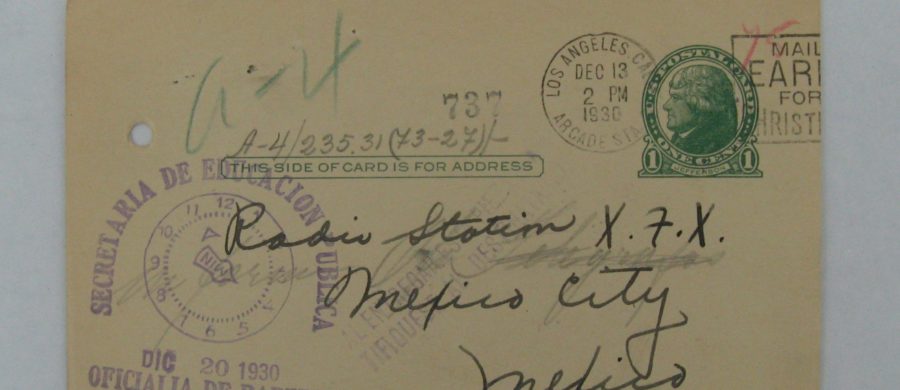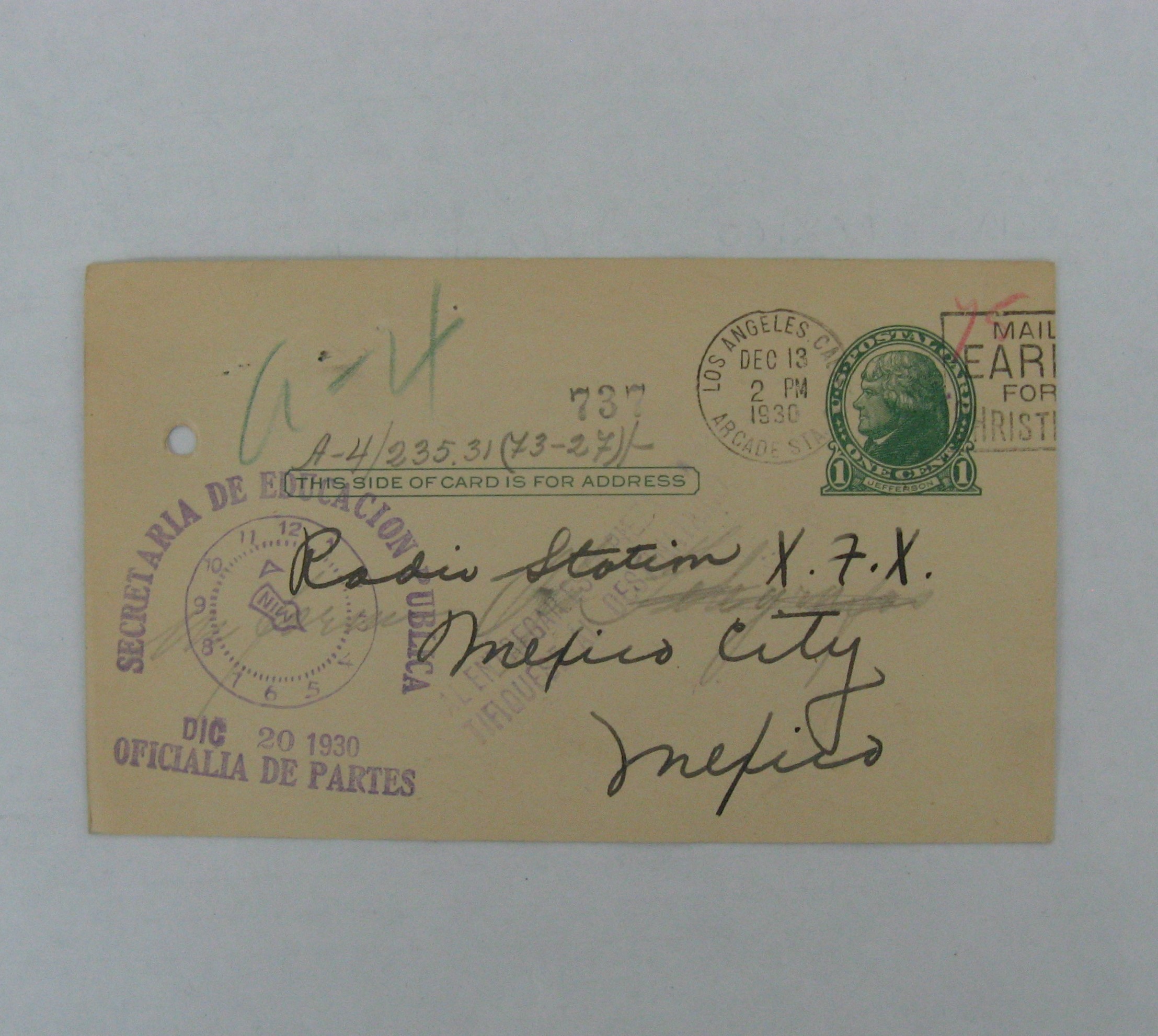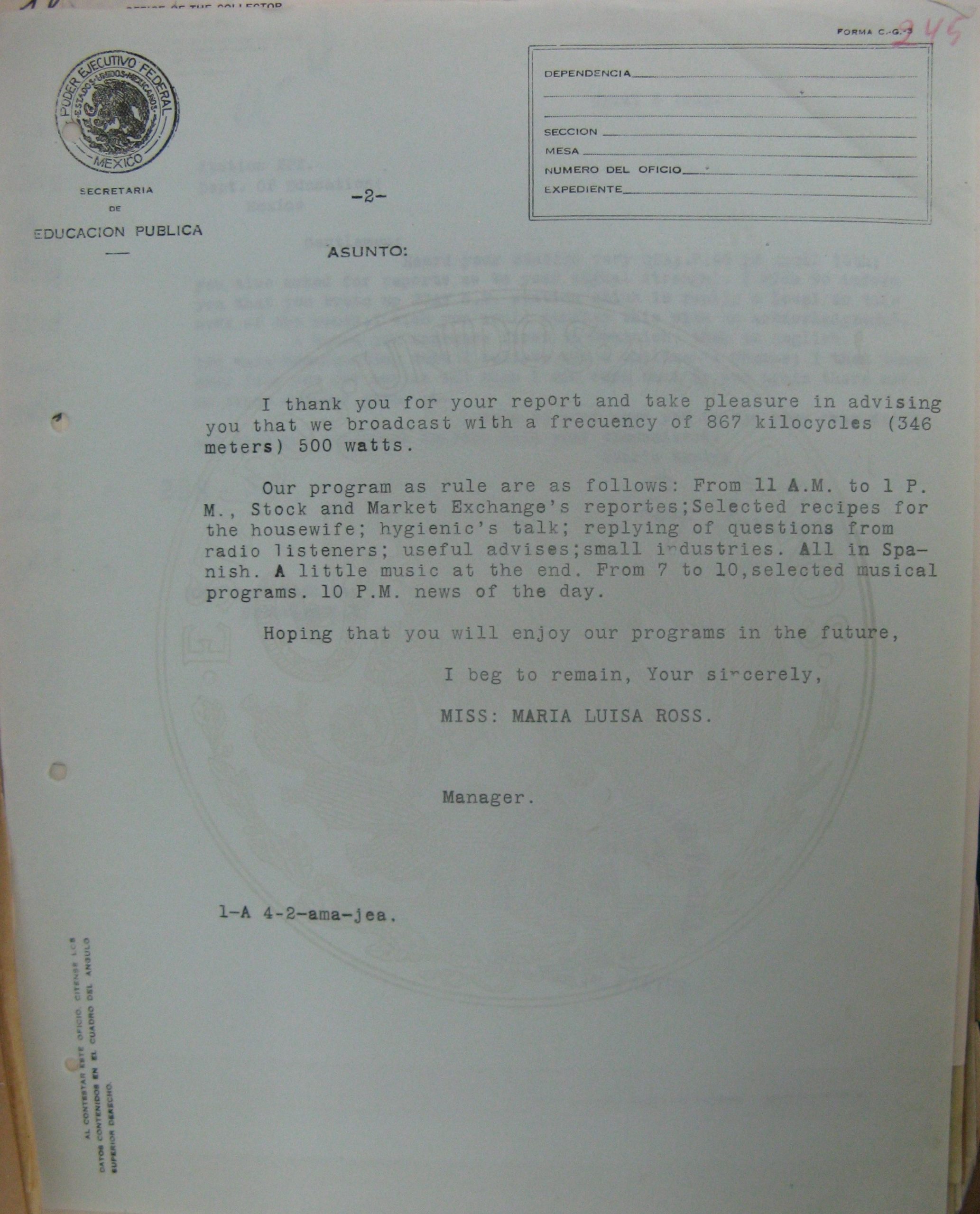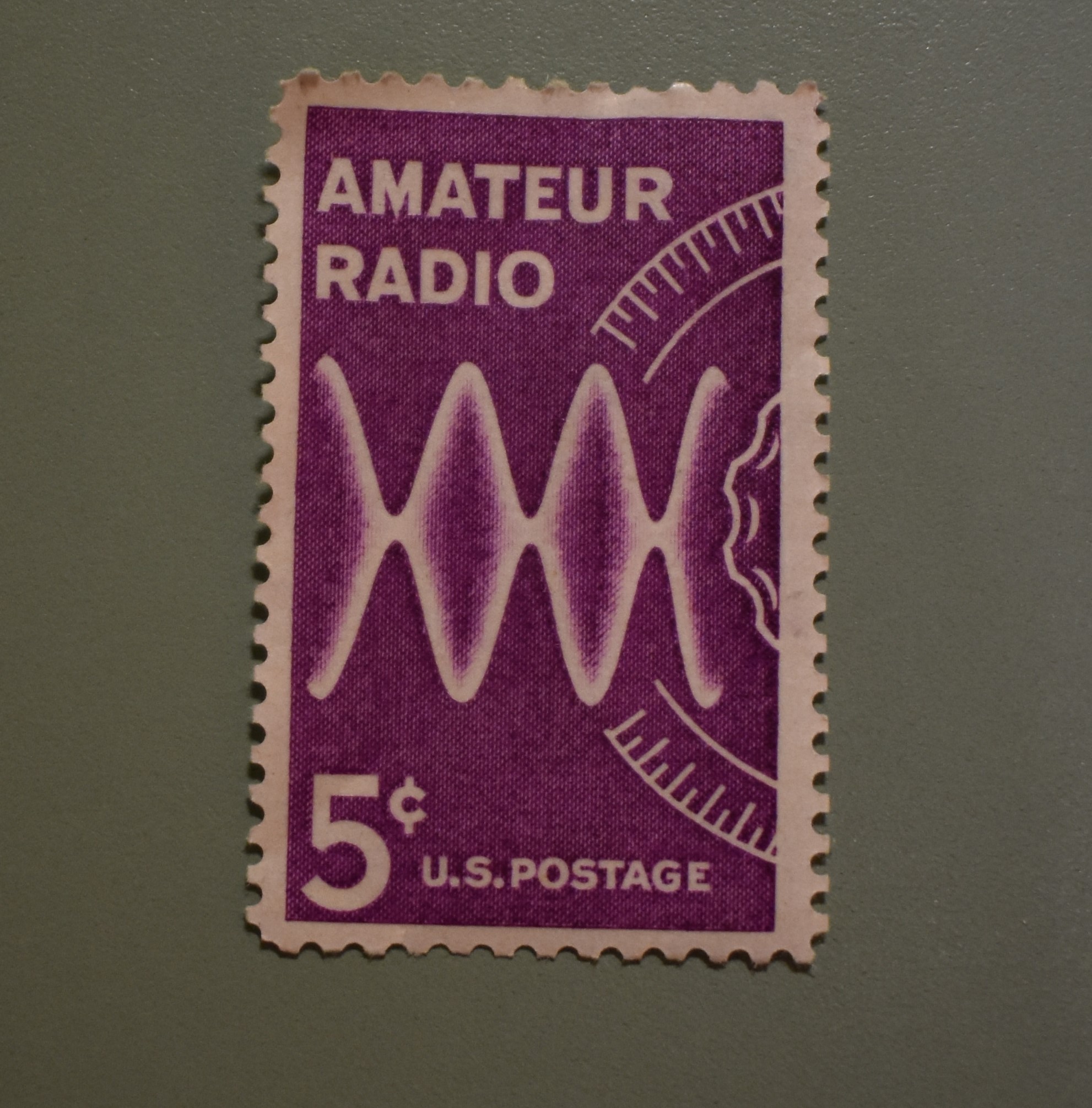
“Good luck and Buenos Notches”: Early Amateur Interactions with Mexican Radio
Technology’s Stories v. 8, no. 2 – DOI: 10.15763/jou.ts.2020.09.28.08
From the mid-1920s to the 1930s hundreds of shortwave radio amateurs in the United States and Canada including DXers (distance fiends, as they called themselves), Mexican citizens, European immigrants, housewives, and teenagers, frequently tuned in to transmissions from Mexican stations and penned letters to their place of origin, Mexico City. Amateurs drafted letters during or immediately after a radio program seeking information for their personal logbooks, requesting a verification report or radio stamp, or many times because they were unsure if what they heard was from Mexico or if the language was Spanish. Correspondence was important to hobbyist culture and helped listeners obtain favorable results. On a number of occasions, XFX, the station administered by the Secretaría de Educación Pública (Mexican Ministry of Public Education, or SEP), responded to their letters.
This exchange is at the center of two interdependent experiences relying on new technologies. First, amateur operators experimented with short wave radio and wrote to Mexicans to give a report or ask for something in return, and, second, a state-sponsored radio station verified the power of its transmitter through correspondence from listeners thousands of miles away. Thus, when “The Scientific Dxer”, the “Raider of the Air Waves” or “The DX Voice of the Historic Maumee Valley of Beautiful Ohio,” wrote to their counterparts in Mexico City, they initiated an exchange that had national and international implications.[1] Radio transmitting and receiving apparatuses were more than tools to reach “distant friends”; they were also portals into a different culture, music, and language for those who “took a little ride” on the shortwaves.[2]
The backstory to this technology story of shortwave radio exchange begins with the formation of radio clubs in the United States after 1912, when the desire to pick up faraway stations was so widespread that DXers gathered to share stories of their adventures over the airwaves.[3] The “scattered brotherhood” of both male and female amateur operators was an integral component in the development of radio broadcasting in countries across the Western Hemisphere.[4] During the 1920s radio programming in the United States flourished because of the technological achievements of the time, commercial interests in radio, government regulation, and the “optimistic spirit of the times.”[5] Examples include the Milwaukee Radio Amateur’s Club, which began in the late 1910s; Round the World DX Club of Los Angeles with hundreds of members; and the Evening News DX Club, which was affiliated with The Buffalo Evening News.[6] And, as Nicholas J. Hock wrote, “Here in Newark we have the Newark News Radio Club. When writing to a station, we in turn write to the Club. When we get an answer we inform the members how the station responds to our request.” (See Figure 1)[7] A decade or two later, such correspondence regularly extended to Mexico, including to the SEP’s XFX station, as we shall see.

Figure 1. The Milwaukee Amateur’s Radio Club reception to Don Mix Press Club. December 1, 1924. Source: Milwaukee Public Library. Local History MSS Collection. Milwaukee Radio Amateurs Club #342
Why the Mexican Ministry of Public Education (SEP)?
During the 1920s and 1930s people in the United States frequently listened to people in Mexico and other Spanish-speaking nations like Cuba, Colombia, and Argentina over the shortwaves. The simple fact that these broadcasts were in a foreign language was appealing and mesmerizing for American amateurs. Radio enthusiast Edward Applebaum, for instance, reported that one early morning in 1931 he listened to eleven Spanish-language stations over a two-hour period, one of which was XFX in Mexico City.[8]
Thousands of hand written and typed letters arrived in the SEP’s radio department’s office beginning in 1925, the year after the station was inaugurated.[9] That year, the manager of the radio department, María Luisa Ross, indicated that on average the station received 26,000 reports per month from listeners in the Western Hemisphere and used the data to estimate that the station’s range exceeded 7,400 miles.[10]
XFX was a cultural, instructive, content-rich station that broadcast a few hours a day in the 1920s.[11] It was not the only Mexican station picked up by amateurs in North America. One February evening in 1931, for example, Oscar Jansen of Los Angeles tuned in to two other commercial stations besides XFX, XEA and XEO.[12] And that same year, A.W. Oppel of New Jersey had heard nine Mexican stations and received verification reports from six of them: XES, XFX, XEW, XEN, XED, and XEH.[13]
Aside from the Ministry of Public Education, a handful of other government institutions also underwrote radio stations in the 1920s including the Ministry of Industry, Commerce and Labor, the Ministry of War and Navy, and the Ministry of Foreign Relations. Yet XFX stood out among the others, in part, because it was the only one which had a national and international mission of instructing and educating peasants, teaching housewives, fathers, and children as well as diffusing “cultural messages” to people in “North American and Central American cities.”[14] In the radio office’s December 1927 report, for instance, María Luisa Ross noted: “Especially in the United States, listening to our music and conferences has awakened an interest to know us better.”[15]
Radio listeners expressed this curiosity by writing that they felt great “pleasure in hearing Mexican stations.” However, they often encountered obstacles, such as not being sure that what they had picked up was XFX’s frequency.[16] “I understood the letters of the station to be XFX. Is this right?” Georgia A. Kuecks of Chicago asked in a letter to the station.[17] From New Jersey, Herbert J. Blythe included the following message in his report: “If this was your station, I should like your verification.”[18] And after listening “At 4:59 A.M. E.S.T. ‘Sweet Adaline’” and “At 5:04 A.M. E.S.T. ‘Hand Me Down My Walking Stick’” the morning of December 21, 1930s, C.S. Wells of Concord, New Hampshire wrote to XFX noting, “If you can identify these selections coming from your station I would be happy to receive verification from you.” (See Figure 2.).[19]

Locating a transmitting station was not always easy and amateurs often spent hours scanning the ether. Short wave enthusiasts built receivers in attics, barns, woodsheds, garages, and other make shift spaces where they could make voice reception audible by scratching a piece of crystal with a thin wire commonly known as a “cat’s whisker”. If the wire was placed on the crystal just so, radio waves transformed into electric current, emitting sounds that could only be heard through headphones. The best times for reception were between midnight and sunrise, because during the day sunlight ionizes the air, charging it with electricity and sapping the strength of radio signals, limiting their service range. Thus, hobbyists twisted and turned their dials in the early morning hours or late at night. And when these hobbyists “caught something,” they often carefully recorded their geographic coordinates, the exact time, the current weather conditions, the name of the station, and, if possible, the message they heard -a speech, a concert, or a phonograph record- in a personal logbook. “One night about Christmas time,” an amateur operator by the name of Roy E. Green wrote to XFX, “I listened to a foreign station from about twelve or one o’clock for about two hours, without ever understanding a word.” (See Figure 3.)[20]

Figure 3. Radio Map of the World. Published by Radio Amateurs News. January 1920. Source: Milwaukee Public Library. Local History MSS Collection. Milwaukee Radio Amateurs Club #342
Dimes and Verification Reports
The Ministry of Public Education’s radio office’s achievements during the first decade XFX was on air were the result of the labor and dedication of its director and manager, María Luisa Ross, who read and wrote fluently in Spanish and English and frequently responded to listeners in the language in which they wrote their letters. “I thank you for your report” a typed letter from her office would read, “Hoping that you will enjoy our programs in the future.” (See Figure 4.)[21]

Figure 4. English-language listener response letter from Maria Luisa Ross. May 12, 1931. Source: Archivo Histórico de la Secretaria de Educación Pública, Expediente A-4/235.3(S-3)/-1 Folio 245
Ms. Ross occasionally went out of her way to address requests and concerns of shortwave listeners in the United States and Canada. When Roy E. Green tuned into XFX on the morning of February 9, 1931, for example, he realized that he was not sure which Mexican station he was listening to and “was only sure of the X”. Nevertheless, he specifically asked for an official reply. “If you answer this my twelve your old daughter would appreciate it greatly if you would be able to enclose a few of your Mexican Postage Stamps (cancelled) for her collection,” Green wrote to XFX’s office the following day.[22] Two and a half weeks later, Ross sent Mr. Green cancelled stamps via airmail.[23]
Listener correspondence included congratulatory notes, requests for a specific song to be played on the air, and even collector’s items, such as the letter from Roy E. Green, yet the bulk of the correspondence from amateurs requested a very particular thing: station verification. In the spring of 1931, L.S. Parody, of Belleville, New Jersey, wrote to XFX indicating he was “anxious to obtain a ‘Verificación de recepción’ from the station.”[24] After disclosing he had “letters from radio stations in New Zealand, Australia, Japan, Hawaii, Cuba, and Canada” M.C. Robinson of Nampa, Idaho confessed he had “never received a verification from Mexico and I would value a message from you very much.”[25]
It was particularly important for amateurs to hear an operator say the station’s call letters for participation or admission in local or national radio clubs. Arthur H. Brackbill wrote to XFX explaining that amateurs were “not allowed to verify unless we hear the call letter of program direct from a station.”[26] In their monthly meetings, club members shared how stations responded to their requests for radio stamps of station verification cards. In November 1930, a letter arrived at the XFX’s radio office from Glendale, California indicating that “the writer,” Mr. E.L. Page, “is very desirous of having your station verify this reception on your official station letter head to that there can be no question as to its origin. An answer written in this manner will help to make my DX files of some value as a record.”[27]
By 1931 station XFX was “considered a very hard one to get in W. Va.,” wrote Herbert E. McCoy. After including the much too common phrase “A radio fan,” he wrote, “Don’t forget to let me hear from you.”[28] Aside from becoming a coveted station from which to pick up and receive an official report, by the early 1930s XFX was a recipient of a curious but not useful thing in Mexico, dimes and cents. “As I am a Member of the Newark Evening News D.X. Club,” James W. Hannon wrote, “I will enclose a 2-cent stamp for a letter of verification if I heard your station correct.”[29]

Figure 5: Amateur radio stamp. Source: Milwaukee Public Library. Local History MSS Collection. Milwaukee Radio Amateurs Club #342
Amateurs like James Pinkerton began to attach dimes and pennies to their letters to Mexico City for a number of reasons, including the wish to receive expedited responses, radio stamps (See Figure 5), for taking the time to write, or for DX club admissions requirements.
Arthur Salgosky of Jersey City reported to XFX on December 14, 1930 that its “Program came over very fine–please find 10 cents for a Radio Stamp or let’s hear from you.”[30] “I understand that you will try to verify any Mexican station that we American listeners hear and are unable to identify,” Mr. Pinkerton wrote, “I am enclosing a dime for your trouble.” (See Figure 6.)[31]

Figure 6. Letter from James Pinkerton to XFX. February 4, 1931. Note the spot at the bottom of the page where he taped a dime. Source: Archivo Histórico de la Secretaria de Educación Pública, Expediente A-4/235.3(S-3)/-1 Folio 114
Conclusion
During the 1920s shortwave radio listeners measured their success by the number of stations that could be reached and logged in a measured period of time. They displayed their radio competency by writing letters, joining clubs, and participating in contests. But letters and listener reports from Mexico and North America are more than curious correspondence from indistinctive listeners abroad; they authenticated the technological power of XFX and proved that Mexico’s nascent radio industry had the capability to cross borders and reach varied audiences. Mexico and the United States, two countries in the same continent with long histories of cultural, commercial, and political exchanges, also shared technological achievements.
This technology story reveals diverse transnational dimensions of broadcasting history and shortwave radio’s international reach. The existing scholarship on broadcasting history notes that amateurs were key players in the incipient stage of radio and that they created a unique technical identity.[32] A few of them, moreover, engaged with unseen international operators and stations, often closing their letters with personal touches as Lionel F. Stetson did when he wrote to XFX and noted: “I want to congratulate you for the New Year and wish you all success in your radio broadcasts. Good luck and Buenos Notches.”[33]
Suggested Readings:
Justin Castro, J. Justin. Radio in Revolution: Wireless Technology and State Power in Mexico, 1897-1938. Lincoln: University of Nebraska Press, 20
Douglas, Susane. Inventing American Broadcasting, 1891-1922. Baltimore: Johns Hopkins Studies in the History of Technology, 1987.
Douglas, Susan. Listening In: Radio and the American Imagination. Minneapolis: University of Minnesota Press, 1998.
Haring, Kristen. Ham Radio’s Technical Culture. Cambridge: MIT Press, 2007.
Hayes, Joy Elizabeth. Radio Nation: Communication, Popular Culture, and Nationalism in Mexico, 1920-1950. Tucson: University of Arizona Press, 2000.
Hilmes, Michelle. Radio Voices: American Broadcasting, 1922-1952. Minneapolis: University of Minnesota Press, 1997.
MacDonald, J. Fred. Don’t Touch That Dial! Radio Programming in American Life, 1920-1960. Chicago: Nelson-Hall, 1979.
Mejía Prieto, Jorge. Historia de la radio y la televisión en México. Mexico City: Colección México Vivo, 1972.
Schwoch, James. The American radio industry and its Latin American activities, 1900-1930. Urbana: University of Illinois Press, 1990.
Copyright 2020 Sonia Robles
Endnotes
[1] AHSEP, Expediente A-4/235.3(S-3)/-1 Folios 93, 94, 120.
[2] AHSEP, Expediente A-4/235.3(S-3)/-1 Folio 118; Newark Evening News. March 25, 1931.
[3] In 1922 The New York Times reported that there were more than 122 wireless clubs in the United States. Susan Douglas, Inventing American Broadcasting, 205. On wireless clubs, see Erik Barnouw, A Tower in Babel: A History of Broadcasting in the United States Volume 1 –to 1933 (New York: Oxford University Press, 1966).
[4] Harry L. Helms, All about ham radio (San Diego: DX/SWL Press Book High Text Publications, Inc., 1992), 12.
[5] J. Fred MacDonald, Don’t Touch That Dial! Radio Programming in American Life, 1920-1960. (Chicago: Nelson-Hall, 1979), 13.
[6] Milwaukee Public Library. Local History MSS Collection. Milwaukee Radio Amateurs Club #342
[7] AHSEP, Expediente A-4/235.3(S-3)/-1 Folio 93.
[8] Newark Evening News. March 25, 1931.
[9] Archivo General de la Nación, Ramo: Secretaría de Comunicaciones y Obras Públicas, Expediente 22/131.6 (725.1)/149
[10] AHSEP 41.8. 9475/15. Caja 4. “Informe especificado acerca de las necesidades futuras para la mejor aplicación de la obra de extensión educativa por radio.” México, 20 de marzo de 1930. Jefe de Extensión Educativa por Radio, María Luisa Ross.
[11] In compliance with the National Radio Congress taking place in Washington, D.C. in 1927, in September 1928 the station was assigned the signals, XFX. By 1936 the station broadcast as XEXM, long wave and XEXA short wave. AHSEP, Expediente A-4/235.3(S-3)/-1 Folio 245.
[12] AHSEP, Expediente A-4/235.3(S-3)/-1 Folio 25.
[13] AHSEP, Expediente A-4/235.3(S-3)/-1 Folio 94.
[14] James Schwoch, The American radio industry and its Latin American activities, 1900-1930. (Urbana: University of Illinois Press, 1990); Boletín de la Secretaría de Educación Pública. Tomo IV, número 2. Mayo 1925. p. 63.
[15] Boletín de la SEP, Tomo VI, no. 12 (1927): 308.
[16] AHSEP, Expediente XII/354.4(73)/-1 Folio 4.
[17] AHSEP, Expediente XII/354.4(73)/-1 Folio 85.
[18] AHSEP, Expediente A-4/235.3(S-3)/-1 Folio 11.
[19] AHSEP, Expediente A-4/235.3(S-3)/-1 Folio 53.
[20] AHSEP, Expediente A-4/235.3(S-3)/-1 Folio 32.
[21] AHSEP, Expediente A-4/235.3(S-3)/-1 Folio 245.
[22] AHSEP, Expediente A-4/235.3(S-3)/-1 Folio 32.
[23] AHSEP, Expediente A-4/235.3(S-3)/-1 Folio 33.
[24] AHSEP, Expediente A-4/235.3(S-3)/-1 Folios 110-111.
[25] AHSEP, Expediente A-4/235.3(S-3)/-1 Folio 150.
[26] AHSEP, Expediente A-4/235.3(S-3)/-1 Folio 391.
[27] AHSEP, Expediente A-4/235.3(S-3)/-1 Folio 391.
[28] AHSEP, Expediente A-4/235.3(S-3)/-1 Folio 148.
[29] AHSEP, Expediente A-4/235.3(S-3)/-1 Folio 241.
[30] AHSEP, Expediente A-4/235.3(S-3)/-1 Folio 77.
[31] AHSEP, Expediente A-4/235.3(S-3)/-1 Folio 114.
[32] Recent work on Ham radio operators (another word for amateur radio operators) includes Kristen Haring, Ham Radio’s Technical Culture (Cambridge: MIT Press, 2007) and “The ‘Freer Men’ of Ham Radio” Technology and Culture; Oct 2003 44, 4, 734-761; Richard A. Bartlett, The World of Ham Radio, 1901-1950: A Social History. (Jefferson: N.C, 2007); Beatriz Scaglia, Wireless telegraphy, old-time radio broadcasting, citizens’ band, and amateur ham: a history of radio (S.I.s.n. 2011).
[33] AHSEP, Expediente A-4/235.3(S-3)/-1 Folio 451.
